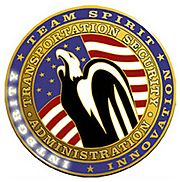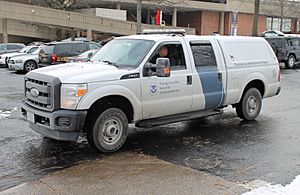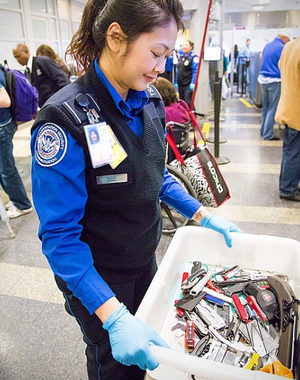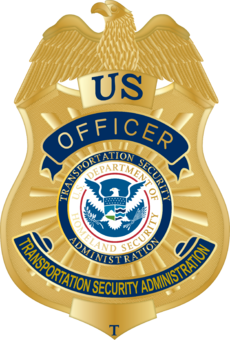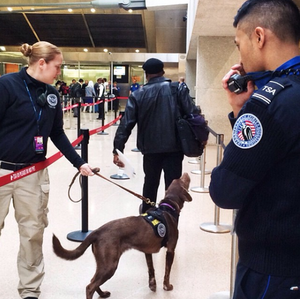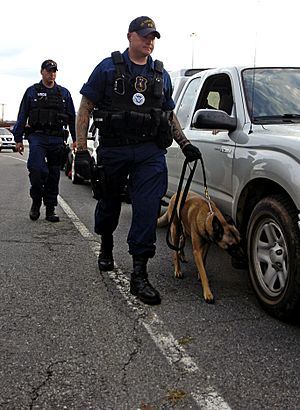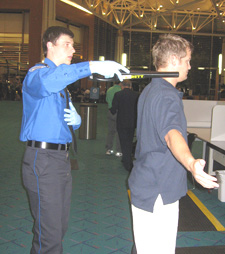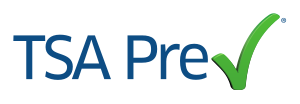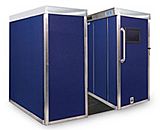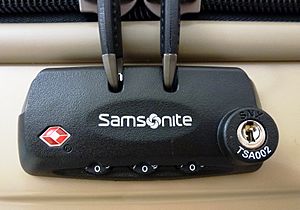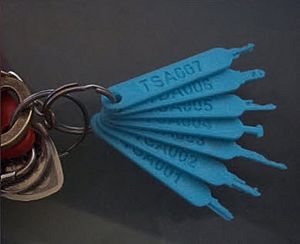Transportation Security Administration facts for kids
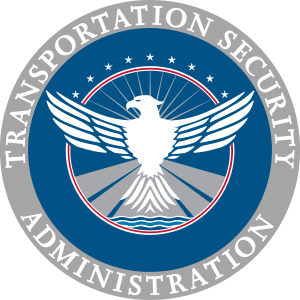
TSA seal
|
|

TSA wordmark
|
|
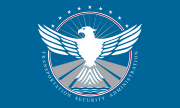 TSA flag |
|
| Agency overview | |
|---|---|
| Formed | November 19, 2001 |
| Preceding agency |
|
| Jurisdiction | Transportation systems inside, and connecting to the United States of America |
| Headquarters | Springfield, Fairfax County, Virginia U.S. |
| Employees | 54,200+ (FY 2020) |
| Annual budget | $ 9.70 billion (FY 2023) |
| Agency executives |
|
| Parent agency | Department of Homeland Security |
The Transportation Security Administration (TSA) is an agency of the United States Department of Homeland Security (DHS) that has authority over the security of transportation systems within, and connecting to the United States. It was created as a response to the September 11 attacks to improve airport security procedures and consolidate air travel security under a dedicated federal administrative law agency.
The TSA develops broad policies to protect the U.S. transportation system, including highways, railroads, buses, mass transit systems, ports, pipelines, and intermodal freight facilities. It fulfills this mission in conjunction with other federal agencies and state partners. However, the TSA's primary focus is on airport security and the prevention of aircraft hijacking. It is responsible for screening passengers and baggage at more than 450 U.S. airports, employing screening officers in airports, armed Federal Air Marshals on planes, mobile teams of dog handlers, and explosives specialists.
Previously part of the Department of Transportation, the TSA became part of DHS in March 2003. It is currently led by Administrator David Pekoske and is headquartered in Springfield, Virginia. As of the fiscal year 2020, the TSA operated on a budget of approximately $7.68 billion and employed over 47,000 Transportation Security Officers, Behavior Detection Officers, Transportation Security Specialists, Federal Air Marshals, and other security personnel.
The TSA has screening processes and regulations related to passengers and carry-on luggage, including identification requirements, pat-downs, full-body scanners, electronic device restrictions, and explosives screening. The agency has faced criticism and controversy throughout its history for the effectiveness of said procedures, as well as baggage theft, data security, and allegations of prejudicial treatment towards certain ethnic groups.
Contents
History and mission
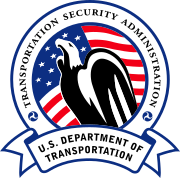
The TSA was created largely in response to the terrorist attacks of September 11, 2001, which revealed weaknesses in existing airport security procedures. At the time, a myriad of private security companies managed air travel security under contract to individual airlines or groups of airlines that used a given airport or terminal facility. Proponents of placing the government in charge of airport security, including Transportation Secretary Norman Mineta, argued that only a single federal agency could best protect passenger aviation.
Congress agreed, and authorized the creation of the TSA in the Aviation and Transportation Security Act, which was signed into law by President George W. Bush on November 19, 2001. Bush nominated John Magaw on December 10, and he was confirmed by the Senate the following January. The agency was initially placed under the United States Department of Transportation but was moved to the Department of Homeland Security when that department was formed on March 9, 2003.
The new agency's effort to hire screeners to begin operating security checkpoints at airports represents a case of a large-scale staffing project completed over a short period. The only effort in U.S. history that came close to it was the testing of recruits for the armed forces in World War II. During the period from February to December 2002, 1.7 million applicants were assessed for 55,000 screening jobs.
Administration and organization
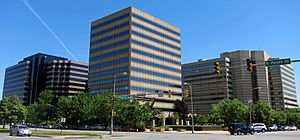
Leadership
When TSA was part of the Department of Transportation, the head of the agency was referred to as the Undersecretary of Transportation for Security. Following the move to the Department of Homeland Security in March 2003, the position was reclassified as the administrator of the Transportation Security Administration.
There have been seven administrators and six acting administrators in the TSA's 19-year history. Several have come to the job after previously serving as Coast Guard flag officers, including Loy, Neffenger, and Pekoske.
Following the passage of the FAA Reauthorization Act of 2018, which included a provision known as the TSA Modernization Act, the administrator's term was set as a five-year term retroactive to the start of current Administrator David Pekoske's term. It also made the deputy administrator a politically appointed position.
| # | Picture | Name | Period | Notes |
|---|---|---|---|---|
| 1 |  |
John Magaw | January 28, 2002 – July 18, 2002 | Under Secretary of Transportation for Security |
| 2 |  |
James Loy | July 19, 2002 – December 7, 2003 | Under Secretary of Transportation for Security until Department of Homeland Security transition. |
| 3 |  |
David M. Stone | December 8, 2003 – June 3, 2005 | Acting until July 2004 when confirmed by United States Senate. |
| — | Kenneth Kasprisin | June 4, 2005 – July 26, 2005 | Acting | |
| 4 |  |
Kip Hawley | July 27, 2005 – January 20, 2009 | |
| — |  |
Gale Rossides | January 20, 2009 – June 24, 2010 | Acting |
| 5 |  |
John S. Pistole | June 25, 2010 —December 31, 2014 | |
| — |  |
Melvin J. Carraway | January 1, 2015 – June 1, 2015 | Acting, reassigned to DHS Office of State and Local Law Enforcement following leak of DHS Inspector General red team test results showing screening failures at TSA checkpoints. |
| — |  |
Mark Hatfield Jr. | June 1, 2015 – June 4, 2015 | Acting |
| — |  |
Francis X. Taylor | June 4, 2015 – July 3, 2015 | Acting, served concurrently as Under Secretary of Homeland Security for Intelligence and Analysis. |
| 6 |  |
Peter V. Neffenger | July 4, 2015 – January 20, 2017 | |
| — |  |
Huban A. Gowadia | January 20, 2017 – August 10, 2017 | Acting |
| 7 |  |
David Pekoske | August 10, 2017 – present | Served concurrently as acting Deputy Secretary of Homeland Security from April 11 to November 13, 2019, with day-to-day operations delegated to Acting Deputy Administrator Patricia Cogswell. Served concurrently as acting Secretary of Homeland Security from January 20, 2021 until Alejandro Mayorkas was confirmed by the Senate. While serving as acting secretary, TSA was overseen by Executive Assistant Administrator for Security Operations Darby LaJoye. |
Organizational structure
At the helm of the TSA is the Administrator, who leads the organization's efforts in safeguarding the nation's airports, railways, seaports, and other critical transportation infrastructure. Assisting the Administrator is a Deputy Administrator, whose role is to provide support and guidance in executing the agency's mission. In addition, the TSA benefits from the expertise and leadership of several Deputy Assistant Administrators and other executive officers, who contribute their knowledge and skills to various aspects of the agency's operations. Together, this structured leadership team forms the backbone of the TSA, working collectively to uphold and enhance the security of the nation's transportation networks. The Executive Assistant Administrator for Law Enforcement is also the Executive Director of the Federal Air Marshal Service.
Rank structure
Headquarters
- Administrator of the TSA
- Chief of Staff
- Executive Secretary
- Ombudsman
- Deputy Administrator
- Deputy Assistant Administrator
- Assistant Administrator
- Executive Director, Airport Operations
- Director, Operations Support
- Director, Airport Services
- Executive Director, Administrative Affairs
- Director, Strategic Communications & Public Affairs
- Director, Strategy, Policy Coordination & Innovation
- Director, Talent Acquisition & Human Capital
- Director, Information Technology
- Director, Training and Development
- Executive Director, Airport Operations
- Deputy Executive Assistant Administrator
- Executive Director, Law Enforcement & Federal Air Marshal Service
- Director, Flight Operations
- Director, Field Operations
- Director, Operations Management
- Executive Director, Security Operations
- Director, Domestic Aviation Operations
- Director, International Operations
- Director, Surface Operations
- Executive Director, Law Enforcement & Federal Air Marshal Service
- Executive Assistant Administrator
- Chief Counsel
- Deputy Chief Counsel
- Chief Counsel
Regional Administration
- Area Director (AD)
- Regional Federal Security Director (R-FSD)
- Federal Security Director (FSD)
- Assistant Federal Security Director for Operations (AFSD/O)
- Assistant Federal Security Director for Screening (AFSD/S)
- Assistant Federal Security Director for Inspection (AFSD/I)
- Assistant Federal Security Director for Law Enforcement (AFSD/LE)
Airport-level
- Transportation Security Manager (TSM)
- Assistant Transportation Security Manager (ATSM)
- Supervisory Transportation Security Officer (STSO)
- Lead Transportation Security Officer (LTSO)
- Transportation Security Officer (TSO)
- Security Support Assistant (SSA)
New headquarters
In August 2017, the General Services Administration announced a new headquarters for the TSA would be built in Springfield, Virginia. The new, 625,000-square-foot headquarters will be a short distance from the Franconia-Springfield Metro station and is projected to cost $316 million for a 15-year lease. The facility is expected to open in mid-2020.
Insignia
On September 11, 2018, TSA adopted a new flag representing its core values and founding principles. The design features a white, graphically stylized American eagle sitting centrally located inside rings of red and white against a field of blue, with its dynamically feathered wings outstretched in a pose signifying protection, vigilance, and commitment. The eagle’s wings, which break through the red and white containment rings, indicate freedom of movement. There are nine stars and 11 rays emanating out from the top of the eagle to reference September 11. There is also a representation of land (roads) and sea which is representative of the modes of transportation.
Operations
Finances
For fiscal year 2020, the TSA had a budget of roughly $7.68 billion.
| Budget | $ Million | Share |
|---|---|---|
| Operations and Support | 4,850 | 63% |
| Procurement, Construction, and Improvements | 110 | 1.4% |
| Research and Development | 23 | 0.3% |
| Not specified | 2,697 | 35% |
| Total | 7,680 | 100% |
Part of the TSA budget comes from a $5.60 per-passenger fee, also known as the September 11 Security Fee, for each one-way air-travel trip originating in the United States, not to exceed $11.20 per round-trip. In 2020, this passenger fee totaled $2.4 billion or roughly 32% of the budget allocated by Congress that year.
Additionally, a small portion of TSA's budget comes from the loose change and cash left behind by travelers at airport security checkpoints, which TSA has been allowed to retain since 2005 under Section 44945 of title 49, United States Code. From FY 2008 through FY 2018, a total of $6,904,035.98 has been left behind, including a record $960,105.49 in FY 2018. In fiscal year 2019, $926,030.44 was unclaimed.
Airport screening
Private screening did not disappear entirely under the TSA, which allows airports to opt-out of the federal screening and hire firms to do the job instead. Such firms must still get TSA approval under its Screening Partnership Program (SPP) and follow TSA procedures. Among the U.S. airports with privately operated checkpoints are San Francisco International Airport; Kansas City International Airport; Greater Rochester International Airport; Tupelo Regional Airport; Key West International Airport; Charles M. Schulz – Sonoma County Airport; and Jackson Hole Airport. However, the bulk of airport screening in the U.S. is done by the TSA's 46,661 (as of FY 2018) Transportation Security Officers (TSOs). They examine passengers and their baggage, and perform other security duties within airports, including controlling entry and exit points, and monitoring the areas near their checkpoints.
Employees
Among the types of TSA employees are:
- Transportation Security Officers: The TSA employs around 47,000 Transportation Security Officers (TSOs). They screen people and property and control entry and exit points in airports. They also watch several areas before and beyond checkpoints. TSOs do not carry weapons, and are not permitted to use force, nor do they have the power to arrest.
Transportation Security Officers (TSOs) provide security and protection for air travelers, airports, and aircraft. This includes:
- Operating various screening equipment and technology to identify dangerous objects in baggage, cargo, and passengers, and preventing those objects from being transported onto aircraft.
- Performing searches and screening, which may include physical interaction with passengers (e.g., pat-downs, a search of property, etc.).
- Controlling terminal entry and exit points.
- Interacting with the public, giving directions, and responding to inquiries.
- Maintaining focus and awareness while working in a stressful environment which includes noise from alarms, machinery and people, crowd distractions, time pressure, and disruptive and angry passengers, to preserve the professional ability to identify and locate potentially life-threatening or mass destruction devices, and to make effective decisions in both crisis and routine situations.
- Engaging in the continuous development of critical thinking skills, necessary to mitigate actual and potential security threats, by identifying, evaluating, and applying appropriate situational options and approaches. This may include the application of risk-based security screening protocols that vary based on program requirements.
- Retaining and implementing knowledge of all applicable Standard Operating Procedures, demonstrating responsible and dependable behavior, and is open to change and adapts to new information or unexpected obstacles.
The key requirements for employment are:
- Be a U.S. Citizen or U.S. National at time of application submission
- Be at least 18 years of age at time of application submission
- Pass a Drug Screening and Medical Evaluation
- Pass a background investigation including a credit and criminal check
- No default on $7,500 or more in delinquent debt (but for some bankruptcies)
- Selective Service registration required
As of September 2019[update] the salary range for a TSO is at least $28,668 to $40,954 per year, not including locality pay (contiguous 48 states) or cost of living allowance in Hawaii and Alaska. A handful of airports also have a retention bonus of up to 35%.
- Behavior Detection Officers: In 2003, the TSA implemented the Screening of Passengers by Observation Technique (SPOT), which expanded across the United States in 2007. In this program, Behavior Detection Officers (BDOs), who are TSOs, observe passengers as they go through security checkpoints, looking for behaviors that might indicate a higher risk. Such passengers are subject to additional screening.
This program has led to concerns about, and allegations of racial profiling. According to the TSA, SPOT screening officers are trained to observe behaviors only and not a person's appearance, race, ethnicity or religion.
The TSA program was reviewed in 2013 by the federal government's Government Accountability Office, which recommended cutting funds for it because there was no proof of its effectiveness. The JASON scientific advisory group has also said that "no scientific evidence exists to support the detection or inference of future behavior, including intent." - Transportation Security Specialist – Explosives, formerly known Bomb Appraisal Officers are explosive specialists employed by TSA. These specialists are required to either be former military Explosive Ordnance Disposal Technicians who attended Naval School Explosive Ordnance Disposal or an FBI certified Public Safety Hazardous Devices Technician who attended the FBI Hazardous Devices School. Furthermore, they are required to possess at least 3 years of experience working in an EOD or bomb disposal unit. The TSS-Es provide workforce training to TSA employees, conduct an Advanced Alarm Resolution process when conventional alarm resolution has failed and serve as a liaison between TSA, law enforcement and bomb squads.
- Federal Air Marshals: The Federal Air Marshal Service is the law enforcement arm of the TSA. FAMs are federal law enforcement officers who work undercover to protect the air travel system from hostile acts. As a part of the Federal Air Marshal Service, FAMs do carry weapons.
The FAM role, then called "sky marshalls", originated in 1961 with U.S. Customs Service (now U.S. Customs and Border Protection) following the first US hijacking. It became part of the TSA following the creation of the TSA following the September 11 attacks, was transferred to the U.S. Immigration and Customs Enforcement in 2003, and back to the TSA in fiscal 2006.
In July 2018, the Boston Globe reported on a secret program called "Quiet Skies", under which armed undercover marshals in airports and on planes keep tabs on passenger behaviors and movements they deemed noteworthy – including abrupt change of direction in the airport, fidgeting, having a "cold penetrating stare", changing clothes, shaving, using phones, even using the bathroom – and send detailed observations to the TSA. The news raised concerns about Constitutional rights by groups like the ACLU and by lawmakers. - Federal Flight Deck Officer (FFDOs) are the airline pilots working for the U.S. airlines, who are sworn and deputized as federal law enforcement officers (FLEOs) to carry out the law enforcement duties within their specific jurisdictions (flight deck) and only from the time their aircraft doors are closed and until they are opened. FFDOs do not have arrest powers but are authorized to carry a federally issued firearm and use force (including deadly force). While the program is voluntary, only active part 121 airline pilots are eligible for the FFDO program. FFDO's are trained by the Federal Air Marshal Service and deputized by the Department of Homeland Security. Their primary goal is to work with (or without) the FAM team to defend the flight deck from hijacking, criminal violence, or any other terrorist threats to their aircraft.
- Transportation Security Inspectors (TSIs): They inspect, and investigate passenger and cargo transportation systems to see how secure they are. TSA employs roughly 1,000 aviation inspectors, 450 cargo inspectors, and 100 surface inspectors. As of July 2018, TSA had 97 international inspectors, are primarily responsible for performing and reporting the results of foreign airport assessments and air carrier inspections, and will provide on-site assistance and make recommendations for security enhancements.
- National Explosives Detection Canine Team Program: These trainers prepare dogs and handlers to serve as mobile teams that can quickly find dangerous materials. As of June 2008[update], the TSA had trained about 430 canine teams, with 370 deployed to airports and 56 deployed to mass transit systems.
- Visible Intermodal Prevention and Response (VIPR) teams: VIPR teams started in 2005 and involved Federal Air Marshals and other TSA crew working outside of the airport environment, at train stations, ports, truck weigh stations, special events, and other places. There has been some controversy and congressional criticism for problems such as the July 3, 2007 holiday screenings. In 2011, Amtrak police chief John O'Connor moved to temporarily ban VIPR teams from Amtrak property. As of 2011, VIPR team operations were being conducted at a rate of 8,000 per year.
Uniforms
In 2008, TSA officers began wearing new uniforms that have a royal blue duty shirt, dark blue (almost black) pants, and black belt. The first airport to introduce the new uniforms was Baltimore-Washington International Airport. Starting on September 11, 2008, all TSOs began wearing the new uniform. One stripe on the outer edge of each shoulder board denotes a TSO, two stripes a Lead TSO, and three a Supervisory TSO.
Officers are issued badges and shoulder boards after completing a trainee period including 3-week academy at the Federal Law Enforcement Training Center (FLETC) in Glynco, Georgia.
Screening processes and regulations
Passenger and carry-on screening
Identification requirements
The TSA requires that passengers show a valid ID at the security checkpoint before boarding their flight. Valid forms of identification include passports from the U.S. or a foreign government, state-issued photo identification, or military ID. Passengers that do not have ID may still be allowed to fly if their identity can be verified through an alternate way.
REAL ID requirements
Passed by Congress in 2005, the Real ID Act established minimum security standards for state-issued driver's licenses and identification cards and prohibits federal agencies, like TSA, from accepting licenses and identification cards for official purposes from states that do not meet these standards.
Enforcement dates
Beginning January 22, 2018, driver's licenses or state IDs issued by states that are not in compliance with the REAL ID Act and have not been granted an extension by DHS may not be used to fly within the U.S.
Beginning May 7, 2025, every traveler will need a REAL ID-compliant license or state ID or another acceptable form of identification to fly within the U.S.
Current list of acceptable IDs
- Driver's licenses or other state photo identity cards issued by Department of Motor Vehicles (or equivalent) per REAL ID enforcement
- U.S. passport
- United States Passport Card
- DHS trusted traveler cards (Global Entry, NEXUS, SENTRI, FAST)
- U.S. Military ID (active duty, retired military or 100% Service-connected disabled veterans and their dependents, and DoD civilians)
- Permanent resident card
- Border Crossing Card
- DHS-designated enhanced driver's license
- Airline- or airport-issued ID (if issued under a TSA-approved security plan)
- Federally recognized, tribal-issued photo ID
- HSPD-12 PIV card
- Foreign government-issued passport
- Canadian provincial driver's license or Indian and Northern Affairs Canada card
- Transportation Worker Identification Credential (TWIC)
- U.S. Merchant Mariner Credential
- Immigration and Naturalization Service Employment Authorization Card (I-766)
- Veteran Health Identification Card (VHIC)
Passenger names are compared against the No Fly List, a list of about 21,000 names (as of 2012[update]) of suspected terrorists who are not allowed to board. Passenger names are also compared against a longer list of "selectees"; passengers whose names match names from this list receive a more thorough screening before being potentially allowed to board. The effectiveness of the lists has been widely criticized on the basis of errors in how those lists are maintained, for concerns that the lists are unconstitutional, and for its ineffectiveness at stopping Umar Farouk Abdulmutallab, who attempted to detonate plastic explosives in his underwear, from boarding an aircraft. At the airport security checkpoint, passengers are screened to ensure they are not carrying prohibited items. These include most sorts of sharp objects, many sporting goods such as baseball bats and hockey sticks, guns or other weapons, many sorts of tools, flammable liquids (except for conventional lighters), many forms of chemicals and paint. In addition, passengers are limited to 3.4 US fluid ounces (100 ml) of almost any liquid or gel, which must be presented at the checkpoint in a clear, one-quart zip-top bag. These restrictions on liquids were a reaction to the 2006 transatlantic aircraft plot.
The number of passengers who have been detected bringing firearms onto airplanes in their carry-on bags has increased in recent years, from 976 in 2009 to 4,239 in 2018, according to the TSA. Indeed, a new record high for firearms found in carry-on bags has been set every year since 2008. In 2010 an anonymous source told ABC News that undercover agents managed to bring weapons through security nearly 70 percent of the time at some major airports. Firearms can be legally checked in checked luggage on domestic flights.
In some cases, government leaders, members of the US military and law-enforcement officials are allowed to bypass security screening.
TSA PreCheck
In a program that began in October 2011, the TSA's PreCheck Program allows selected members of American Airlines, Delta Air Lines, United Airlines, Alaska Airlines, Hawaiian Airlines, Virgin America, Southwest Airlines, Air Canada, JetBlue, and Sun Country Airlines frequent flyer programs, members of Global Entry, Free and Secure Trade (FAST), NEXUS, SENTRI and members of the US military, along with cadets and midshipmen of the United States service academies to receive expedited screening for domestic and select international itineraries. As of March 2019, this program was available at more than 200 airports. After completing a background check, being fingerprinted, and paying an $85 fee, travelers will get a Known Traveler Number. The program has led to complaints of unfairness and longer wait lines. Aeromexico, Etihad Airways, Cape Air, and Seaborne Airlines joined the program bringing the total number of member carriers to 16. On December 15, 2015, the program expanded to include Allegiant Air. On June 21, 2016, it was announced that Frontier Airlines and Spirit Airlines will also join the program starting in the fall of 2016. On August 31, 2016, the program expanded to include Lufthansa, and on September 29, 2016, Frontier Airlines was added. In 2017, 11 more airlines were added on January 26, and another seven were added on May 25. As of March 2019, a total to 65 carriers were participating in the program.
In October 2013, the TSA announced that it had begun searching a wide variety of government and private databases for information about passengers before they arrive at the airport. They did not say which databases were involved, but TSA has access to past travel itineraries, property records, physical characteristics, law enforcement, and intelligence information, among others.
Large printer cartridges ban
After the October 2010 cargo planes bomb plot, in which cargo containing laser printers with toner cartridges filled with explosives were discovered on separate cargo planes, the U.S. prohibited passengers from carrying certain printer cartridges on flights. The TSA said it would ban toner and ink cartridges weighing over 16 ounces (453 grams) from all passenger flights. The ban applies to both carry-on bags and checked bags, and does not affect average travelers, whose toner cartridges are generally lighter.
November 2010 enhanced screening procedures
Beginning in November 2010, TSA added new enhanced screening procedures. Passengers are required to choose between an enhanced patdown, allowing TSOs to more thoroughly check areas on the body such as waistbands and inner thigh. or instead to be imaged by the use of a full body scanner (that is, either backscatter X-ray or millimeter wave detection machines) in order to fly. These changes were made in reaction to the Umar Farouk Abdulmutallab bombing attempt.
Pat-downs
The new pat-down procedures involve the touching of private body parts. These procedures were controversial, and in a November 2010 poll, 50% of those polled felt that the new pat-down procedures were too extreme, with 48% feeling them justified. A number of publicized incidents created a public outcry against the invasiveness of the pat-down techniques. Pat-downs are carried out by agents of the same gender as the passenger.
Concerns were raised as to the constitutionality of the new screening methods by organizations such as the American Civil Liberties Union. As of April 2011, at least six lawsuits were filed for violation of the Fourth Amendment.
Full body scanners
TSA has used two kinds of full body imaging technology since first deploying them in airports in 2010. Previously backscatter X-ray scanners were used which produced ionizing radiation. After criticism the agency now uses only millimeter wave scanners which use non-ionizing radiation. The TSA refers to both systems as Advanced Imaging Technologies or AIT. Critics sometimes refer to them as "naked scanners," though operators no longer see images of the actual passenger, which has been replaced by a stick figure with boxes indicating areas of concern identified by the machine. In 2022, TSA announced it will allow passengers to select the gender marker of their choice and alter algorithms used by the machines to be inclusive of transgender, nonbinary, and gender-nonconforming individuals. Previously the agency required screeners to select a male or female button based on a brief glance at the passenger as they entered the machine.Passengers are directed to hold their hands above their heads for a few seconds while front and back images are created. If the machine indicates an anomaly to the operator, or if other problems occur, the passenger is required to receive a pat-down of that area.
Full-body scanners have also proven controversial due to privacy and health concerns. The American Civil Liberties Union has called the scanners a "virtual strip search." Female passengers have complained that they are often singled out for scanning, and a review of TSA records by a local CBS affiliate in Dallas found "a pattern of women who believe that there was nothing random about the way they were selected for extra screening."
The TSA, on their website, states that they have "implemented strict measures to protect passenger privacy which is ensured through the anonymity of the image," and additionally states that these technologies "cannot store, print, transmit or save the image, and the image is automatically deleted from the system after it is cleared by the remotely located security officer." This claim, however, was proven false after multiple incidents involving leaked images. The machines do in fact have the ability to "save" the images and while this function is purported to be "turned off" by the TSA in screenings, TSA training facilities have the save function turned on.
As early as 2010, the TSA began to test scanners that would produce less intrusive "stick figures". In February 2011, the TSA began testing new software on the millimeter-wave machines already used at Amsterdam's Schiphol Airport that automatically detects potential threats on a passenger without the need for having an officer review actual images. Instead, one generic figure is used for all passengers and small yellow boxes are placed on areas of the body requiring additional screening. The TSA announced in 2013 that the Rapiscan's backscatter scanners would no longer be used since the manufacturer of the machines could not produce "privacy software" to abstract the near-nude images that agents view and turn them into stick-like figures. The TSA continues to use other full-body scanners.
Health concerns have been raised about both scanning technologies.
With regards to exposure to radiation emitted by backscatter X-rays, and there are fears that people will be exposed to a "dangerous level of radiation if they get backscattered too often". A petition by both scientists and pilots argue that the screening machines are safe. Ionizing radiation is considered a non-threshold carcinogen, but it is difficult to quantify the risk of low radiation exposures. Active millimeter wave scanners emit radiation which is non-ionizing, does not have enough energy to directly damage DNA, and is not known to be genotoxic.
Reverse screenings
In April 2016, TSA Administrator, Peter V. Neffenger told a Senate committee that small airports had the option to use "reverse screening" – a system where passengers are not screened before boarding the aircraft at departure, but instead are screened upon arrival at the destination. The procedure is intended to save costs at airports with a limited number of flights.
March 2017 electronic device restrictions
On March 21, 2017, the TSA banned electronic devices larger than smartphones from being carried on flights to the U.S. from 10 specific airports located in Muslim-majority countries. The order cited intelligence that "indicates that terrorist groups continue to target commercial aviation and are aggressively pursuing innovative methods to undertake their attacks, to include smuggling explosive devices in various consumer items". The restrictions were ended in July following changes in screening procedures at the specified airports.
Checked baggage
In order to be able to search passenger baggage for security screening, the TSA will cut or otherwise disable locks they cannot open themselves. The agency authorized two companies to create padlocks, lockable straps, and luggage with built-in locks that can be opened and relocked by tools and information supplied by the lock manufacturers to the TSA. These are Travel Sentry and Safe Skies Locks. TSA agents sometimes cut these locks off instead of opening them, and TSA received over 3,500 complaints in 2011 about locks being tampered with. Travel journalist and National Geographic Traveler editor Christopher Elliott describes these locks as "useless" at protecting the goods within, whereas SmarterTravel wrote in early 2010 that the "jury is out on their effectiveness", while noting how easy they are to open.
In November 2014, The Washington Post inadvertently published a photograph of all seven of the TSA master keys in an article about TSA baggage handling. The photograph was later removed from the original article, but it still appears in some syndicated copies. In August 2015, this gained the attention of news sites. Using the photograph, security researchers and members of the public have been able to reproduce working copies of the master keys using 3D printing techniques. The incident has prompted discussion about the security implications of using master keys.
Non-Airport Regulation
While most known for their role in Airports, the TSA is also responsible for other transportation related regulations, including those without passengers. For example, the TSA was responsible for setting up cybersecurity regulations after the Colonial Pipeline ransomware attack in May 2021. As of August 2022, they issued revised cybersecurity directives for oil and gas providers more focused on performance-based measures, following extensive input from federal regulators and private industry stakeholders.
See also
- Airline complaints
- Border Force (one of the two successor agencies to the United Kingdom Border Agency; the other being UK Visas and Immigration)
- Canadian Air Transport Security Authority
- International Civil Aviation Organization
- Lost luggage
- Okoban


